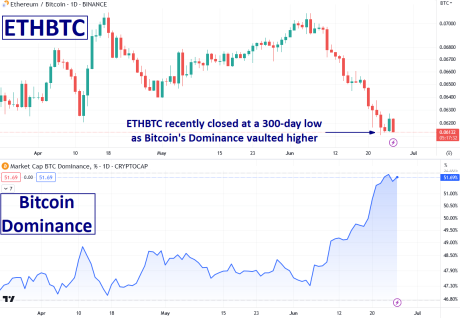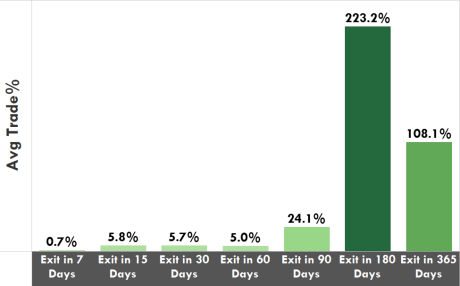Reason to trust

How Our News is Made
Strict editorial policy that focuses on accuracy, relevance, and impartiality
Ad discliamer
Morbi pretium leo et nisl aliquam mollis. Quisque arcu lorem, ultricies quis pellentesque nec, ullamcorper eu odio.
While crypto traders have been emboldened by Bitcoin’s impressive rally, especially in light of the SEC’s recent lawsuits against major crypto exchanges Binance and Coinbase, one key trading pair has nevertheless suffered as a result. Ethereum/Bitcoin (ETHBTC), the widely watched trading pair which combines the crypto market’s number two coin with its number one coin by market cap, just closed at a 300-day low. Why is this happening and what’s happened in the past after similarly weak periods for ETHBTC? Let’s take a closer look at the price history to find out.
Bitcoin’s Dominance Explodes Higher
Just a few weeks ago, ETHBTC closed at a multi-week high and looked poised to move higher, but the recent surge in Bitcoin Dominance caused ETHBTC to hit a 300-day low, just shy of a new 52-week low.
The popular Dominance metric can be calculated for any crypto market asset and is simply a measure of any coin or token’s share of the total cryptocurrency market’s capitalization, expressed as a percentage.
Bitcoin Dominance now sits at just over 51% after climbing from below 42% at the start of the year. Why the surge in Bitcoin’s Dominance? A variety of factors appear to have contributed to the sudden jump in Bitcoin’s Dominance chart, with Blackrock’s recent filing for a new spot Bitcoin ETF arguably being the key driver.

ETHBTC and Bitcoin Dominance Comparison | SOURCE: TradingView.com
While both Bitcoin (BTC) and Ethereum (ETH) have moved sharply higher in recent sessions, Bitcoin’s recent relative strength to Ether has pushed ETHBTC to a multi-month low. Let’s take a look at what past 300-day lows for ETHBTC have meant for this key crypto market ratio.
As always, because the number of occurrences will vary depending on holding time, we’ll start by listing the number of times that ETHBTC has closed at a 300-day low next to our hypothetical hold times of 7 days, 15 days, 30 days, 60 days, 90 days, 180 days, and 365 days. Holding time is defined as the amount of time one held an asset before exiting. For example, if one had hypothetically purchased ETHBTC following the trigger event (i.e., the close at a 300-day low) and sold it 90 days later, this would be a holding time of 90 days.
ETHBTC Occurrences of 300-Day Lows by Holding Time (Inception – Present)
- 13 occurrences using a 7-day hold time
- 10 occurrences using a 15-day hold time
- 7 occurrences using a 30-day hold time
- 5 occurrences using a 60-day hold time
- 5 occurrences using a 90-day hold time
- 4 occurrences using a 180-day hold time
- 3 occurrences using a 365-day hold time
As we can see, there have been relatively few closes at 300-day lows for ETHBTC, especially with longer holding times.
Ethereum Relative Strength May Be Poised To Climb
While 300-day lows may sound bearish, the data suggests that ETHBTC may now be poised for a bounce, particularly with a longer holding period. Hypothetical short-term holding times from 7 days to 60 days show a modest average result, and historically positive across the board. In other words, past instances when ETHBTC has hit a 300-day low have seen a modest bounce higher, coming in at just over 5% on average when using a 15-day, 30-day, or 60-day hold time.

ETHBTC Average Trade Result with Various Hold Times | SOURCE: Tableau
From an intermediate-term perspective, however, history shows that ETHBTC gains far more significantly, from +24.1% with a 90-day hold, to an astounding +223.2% with a 180-day hold, to an impressive 108.1% with a one-year hold.
While many Bitcoin maximalists may be calling for significantly higher Bitcoin Dominance readings and lower ETHBTC levels as a result, the data says otherwise. While the past does not predict the future, ETHBTC may eventually be poised for higher levels, though patience might be required in the short-term.



















